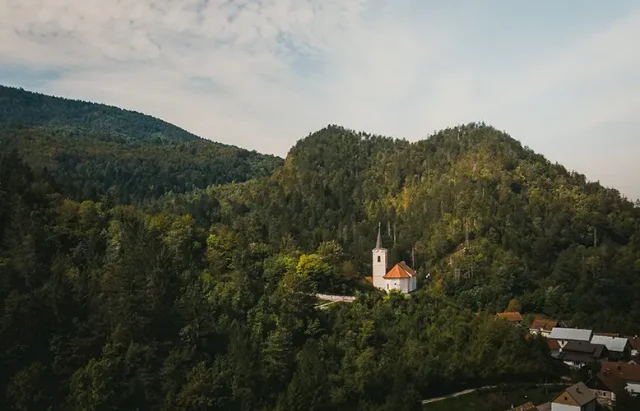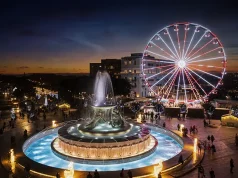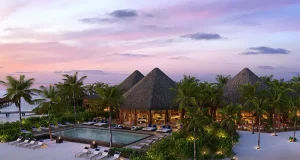
There are places in Slovenia where the forest feels endless. Kočevsko is one of them. Located in the south of the country, far from the main highways and tourist routes, it is a land of deep woods, hidden lakes, and quiet villages. The trees here have stood for centuries, untouched by wars or progress, and their silence feels almost alive.
This is not a landscape made for spectacle. It asks for patience. The forest does not reveal itself easily, and it does not need to. Light filters through layers of leaves and moss, and the air smells of soil and pine resin. When you walk through it, the world slows down until every sound — the crunch of a branch, the call of a jay, the movement of the wind — becomes something you can feel.
The Kingdom of Trees
Kočevsko is one of the most densely forested regions in Europe. More than ninety percent of it is covered by trees, many of them centuries old. Some of these woods, like the Krokar Primeval Forest, are part of a UNESCO World Heritage Site. They represent what Europe once looked like before roads, towns, and agriculture began to shape the land.
In Krokar, beech trees rise like pillars in a natural cathedral. The ground is soft with leaves, and streams run cold and clear between the roots. There are no trails through the heart of the forest, only marked boundaries to protect it from human intrusion. It is one of the few places on the continent where nature still rules completely, where everything grows, falls, and returns to earth in its own time.
Outside the protected core, the wider Kočevsko region invites exploration. Trails weave through woods and across clearings, connecting small hamlets where people live quietly among the trees. Here, the landscape still sets the rhythm of life.
The People and the Land
The people of Kočevsko are known for their resilience. For generations they have lived between mountains and forest, working the land, raising animals, and adapting to the seasons. Many of the villages were once home to German-speaking settlers, known as Gottschee Germans, who arrived in the Middle Ages and left during the turmoil of the twentieth century. Their traces remain in old stone walls, orchards reclaimed by the forest, and stories that locals still tell.
Life here has always been about balance — taking what the land gives, but never more than it can offer. The modern generation has rediscovered this wisdom. Organic farms, forest lodges, and eco-retreats have grown in recent years, built not as intrusions but as continuations of the environment.
It is easy to sense the respect that still defines Kočevsko. Even the newest buildings use wood from nearby sawmills, their forms simple and quiet. The forest is not decoration here. It is a neighbor.
The Way of Movement
Most travelers come to Kočevsko to walk, but cycling has become another way to move through the landscape. Forest roads twist between hills and rivers, and the terrain shifts gently between valley and ridge. Many Slovenia cycling tours now include routes through Kočevsko, designed for those who want to experience the wilderness without disturbing it.
The rides are slow and silent. You pass through long tunnels of trees, past clearings where deer graze in the distance, and along paths where the only sound is the turning of wheels on gravel. Some routes lead to the Rinža River, a watercourse that disappears into underground karst passages and re-emerges miles away. Others climb toward the peaks of Stojna or Rog, where the forest opens briefly to reveal views of endless green.
It is travel stripped to its essentials — no traffic, no noise, just the steady rhythm of breath and motion.
The Presence of the Wild
Kočevsko is one of the few regions in Europe where bears, lynx, and wolves still roam freely. They move quietly through the forest, unseen by most visitors, though their presence is always felt. Locals treat them with calm respect. There are signs along the trails explaining how to behave if you encounter one, but the animals keep their distance.
For those who wish to understand this coexistence, local guides offer bear-watching experiences. They do not promise sightings, only the chance to spend an evening in the stillness of the woods, listening. The waiting itself becomes part of the experience — an exercise in patience and awareness.
When darkness falls and the first stars appear between branches, the forest changes character. The air cools, the sound of the river deepens, and the feeling of being small in something vast becomes unmistakable.
The Village at the Edge
The town of Kočevje stands quietly on the edge of this wilderness. It is small, with wide streets, a calm lake, and a sense of measured life. From here, trails lead outward in every direction. Cyclists and hikers stop in the local cafés to rest, order soup or herbal tea, and plan the next part of their route.
Near the lake, wooden platforms reach out over the water, offering reflections of forest and sky. Children swim here in summer, and herons circle above. The stillness feels deep but never lonely. It carries the same quiet strength that defines the entire region.
Kočevje is also home to a small but growing community of artists and craftspeople. They work with natural materials — wood, clay, wool — and many have settled here to find the peace that cities can no longer offer. Their studios are hidden among the trees, their work shaped by the rhythm of the land.
A Forest that Remembers
The beauty of Kočevsko lies not in its perfection but in its endurance. It remembers everything — the people who once lived here, the wars that passed through, the seasons that keep returning. The forest carries these memories without effort, holding them in its roots and its silence.
To walk or cycle here is to enter a kind of living archive, where time is measured not by clocks but by growth and decay. The trees fall, the soil renews, and the air remains pure. The forest does not ask for attention, yet it gives you clarity.
Kočevsko reminds you that quiet is not emptiness. It is presence.





